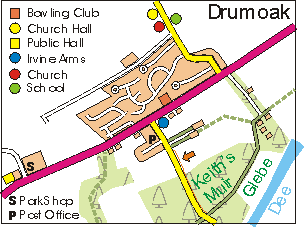 |
||||||||||||||||||
|
|
||||||||||||||||||
|
Except as otherwise noted, all material on this website is copyright, 1997 to 2015. |
||||||||||||||||||
|
Website visitors since 15/1/03 |
||||||||||||||||||
|
|
||||||||||||||||||
|
THIS MAP IS CLICKABLE. JUST CLICK ANY OBJECT (WHERE POINTER BECOMES A HAND) TO GO TO THE RELEVANT WEBPAGE OR SITE. |
||||
|
Drumoak has evolved from the holy well and church of St Malik by the river ford at Dalmaik, gradually shifting its community up to Drum and then towards the centre of the parish at the present village. Drumoak is the largest by population of the three main settlements. The ma Drumoak has a Beaver Colony (contact Kathleen Murray, 01330 820356) and a Brownie Pack (contact Karen Massie, 01330 811906). Dee Valley Caravans operates from the former Park station yard. Drumoak also has the bowling green and clubhouse of the Drumoak Durris Crathes Bowling Club. The settlement of Drumoak itself is home to the largest concentration of houses between Culter and Banchory. The Drumoak area is bounded by the outskirts of Peterculter in the east, Crathes in the west and the Gormack Burn to the north. The River Dee itself forms the southern boundary. Eastwards from Drumoak, near the former Drum station, there are Drumoak Kitchens, Deeside Nurseries and the Heather Centre. To the West is Ande A monograph (right), commissioned by the Kirk Session of Drumoak Church to celebrate the end of the second millennium and written by Robin Jackson, contains “a series of cameos” about Drumoak as it was and is. Essential reading for those interested in the thousand-year history (and much longer prehistory) of Drumoak. Available via Amazon - click here. North of Drumoak (although best accessed via the turning off the North Deeside Road (A93) at Mains of Drum) lie the grounds and delightful walled rose garden of the 12th Century Drum Castle - click here Drum is the oldest intact castle owned by the National Trust for Scotland. Drum is one of two very fine castles in the immediate area - the other being Crathes. Drumoak contains about 945 electors and 503 households (of which 216 are outside the settlement). |
||||
 p shows the settlement of Drumoak, which has a Post Office (tel no. 01330 811 201), a pub (The Irvine Arms - tel no. 01330 811 423), a shop (a short walk to the West of Drumoak at Park - tel no. 01330 811 463), a
p shows the settlement of Drumoak, which has a Post Office (tel no. 01330 811 201), a pub (The Irvine Arms - tel no. 01330 811 423), a shop (a short walk to the West of Drumoak at Park - tel no. 01330 811 463), a  rson’s Smithy.
rson’s Smithy.